Working Backwards from a Graph
Purplemath
The other exercise type is when you are given two graphs, one being the original function and the other being the transformed function, and you're asked to figure out the formula for the transformation.
Content Continues Below
How do you find the formula for a transformed graph?
The best way I've found to find the formula for a transformed graph is to locate a point that I can clearly track, such as the vertex of a parabola or a turning point (that is, a max/min point) on a cubic. Then I'll try to figure out what that point did, how it moved, in going from A to B. That is, I'll find a sequence of steps (moving right, sliding down, etc) that works for that point. Then I'll check some other point, or the general shape of the graph, to confirm that my sequence of steps works there, too.
-
Given the graphs, below, of f (x) and its transformation, find an expression for the transformation in terms of f (x).
the orginal graph
graph of the transformation
These two graphs appear to have the same shape (in terms of width), so I'm going to guess that nothing was multiplied on the outside or the inside of the function. This lack of multiplicative transformation is usually the case, because these multiplications are quite difficult to discern from the pictures — but I like to have checked anyway.
The most distinguishable point on each of the graphs is the vertex of each parabola. So I'll try to track the movement of the vertex.
Both parabolas are right-side up, so the graph wasn't flipped upside-down. If there was any reflection in the vertical axis, I wouldn't be able to tell on a parabola, anyway. So I can eliminate a minus multiplied either inside or outside the function.
It looks to me like the original vertex was moved up by three units, so I'll have a "+3" on the outside of my new functional rule. And it looks to me as though the vertex was also shifted to the right by two units, so I'll have a "−2" inside the new rule's argument. Putting these together, my rule for the transformation is:
f (x − 2) + 3
Affiliate
-
Given the graphs, below, of f (x) and its transformation, find an expression for the transformation in terms of f (x)
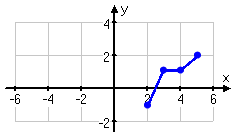
the orginal graph
graph of the transformation
This one is harder than the previous one. Because of how the second graph is oriented with respect to the first, I can tell that the graph must have been mirrored across the y-axis at some stage in the transformation. This means that I'll be needing a "minus" sign on the variable inside the argument.
Affiliate
The two graphs have the same shape; neither one is taller, shorter, wider, etc, than the other. This tells me that they didn't do one of the multiplication transformations.
I'll keep track of what's going on by picking one point that is off the axes, and then tracing what I think they must have done to the original function in order to get that point to move to its new location. Then I'll check my work by picking some other point, and making sure that my sequence of moves works for that point, too.
To start, I'll use the bottom point of the original graph; namely, the point (2, −1). (There's nothing special about this point; it just happens to be the one I picked first.)
The point (2, −1) moves to (1, −1), and the function does a flip around the y-axis. There doesn't appear to be any upward or downward movement, though. So I'll just be doing a side-to-side move, and then a flip about the vertical axis.
Before the flip around the vertical axis, the point (1, −1) must have been located at (−1, −1). This means that the original point (2, −1) was shifted back to the left by three units, so there must be a "+3" inside the argument. That gives me a transformation of f (x + 3), before the flip across the axis. The flip requires a "minus" sign on the variable, so then the entire transformation must be f (−x + 3).
Before I hand this in, I'll check to make sure that this moves other points the right way, too. Looking at (3, 1), shifting three units to the left takes the point to (0, 1); the flip around the y-axis leaves the point unchanged. Looking at (5, 2), shifting back to the left by three units takes the point to (2, 2) and flipping the point around the y-axis takes the point to (−2, 2). Since applying my steps to the other points checks out okay on them as well, it appears that I have found the correct transformation.
My final answer is:
f (−x + 3)
By the way, there isn't just this one way to arrive at the answer. Another way to look at this is to flip the graph first, putting a "minus" on the variable, yielding the transformation step f (−x). But flipping first moves the graph too far off to the left, taking, for instance, the original point (5, 2) to (−5, 2). To correct this, I have to follow this up with a shift back to the right by three units: f (x) to f (−x) to f (−(x − 3)) = f (−x + 3).
As you can see, it's probably going to be easier to keep track of things if you leave any "reflecting in the vertical axis" part until the end.
Content Continues Below
-
Determine the transformation which changed the first graph into the second graph.

graph of original function
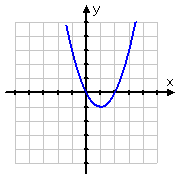
graph of transformed function
The two graphs appear to have the same shape, so I'll assume that there were no multiplication transformations involved here.
Clearly, the graph was flipped upside-down at some point. I'll leave that to the end. After the flip over the x-axis, the vertex is at the point (1, −1). Then, before the flip, the vertex was at (1, 1).
This is two units below the original vertex at (−2, 3), and three units to the right. So there's a "minus three" inside the argument of the function, and a "minus two" outside of it. So the function moved from f (x) to f (x − 3) to f (x − 3) − 2. Then the whole thing was flipped by having a "minus" put on the whole thing:
−[ f (x − 3) − 2] = −f (x − 3) + 2
Then my final answer is:
−f (x − 3) + 2
Affiliate
In practice, about the only time you'll actually use function transformations (before you get to trigonometry) is with conics; that is, with parabolas and such. For instance, since you know what the basic quadratic y = x2 looks like, you now know that y = (x + 3)2 − 2 is the same parabola shape, but with the whole graph (and, in particular, the point at the origin) having been moved back three units and down two so, in particular, the vertex is now at (−3, −2) in the third quadrant.
In a somewhat related way, given that x2 + y2 = r2 is the equation of a circle with radius r centered at the origin, the equation (x + 1)2 + (y − 1)2 = 4, for instance, would be the equation of the circle with radius 2 and centered at (−1, 1). (Of course, a circle equation isn't a function, so this doesn't technically fall under the heading of "function transformations", but you should note the similarity anyway; you'll be expected to make this connection.)
I think the main point that they want you to get is that certain types of equations always have certain kinds of shapes; for instance, ax2 + bx + c is always a parabola, etc. In practice, though, you won't be using function transformation very much, at least not until you're some way into trigonometry. For now, just make sure you know how to do it for the test — these questions are easy points, once you get how they work — but don't worry if you forget all about it later. If you need the subject again (for instance, in trigonometry), they'll cover it again.
URL: https://www.purplemath.com/modules/fcntrans5.htm
Select a Course Below
Standardized Test Prep
Homeschool Math
© 2024 Purplemath, Inc. All right reserved. Web Design by ![]()



